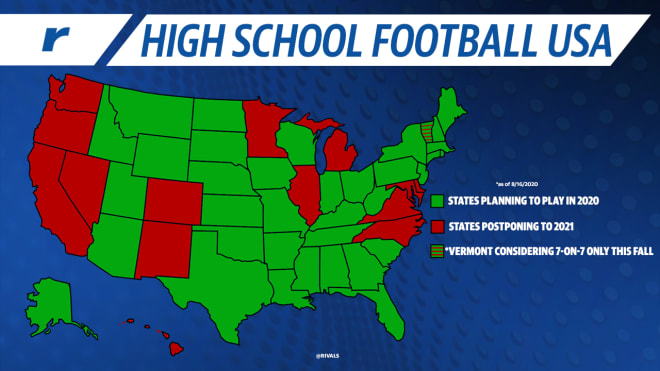Approaches to high school football vary by state

The first football games of the 2020 high school season kicked off last week in Utah, but in some states not a single down will be played until 2021.
On Friday, Michigan became the 14th state to cancel its fall high school football season, with plans to try to play next spring. All remaining fall high school sports in Michigan are still on track to be played in their season; football is the lone exception.
“At the end of the day, we did everything we could to find a path forward for football this fall,” MHSAA Executive Director Mark Uyl said in the association’s press release. “But while continuing to connect with the Governor’s office, state health department officials, our member schools’ personnel and the Council, there is just too much uncertainty and too many unknowns to play football this fall.”
RELATED: Five-star Jack Sawyer to sit out senior year
CLASS OF 2021 RANKINGS: Rivals250 | Position | Team | State
CLASS OF 2022: Top 100
College football’s Power Five Conferences have come to no consensus on whether to play a 2020 season, and high school athletic associations across the country have, likewise, dealt with the issue of the coronavirus pandemic very differently.
While a majority of state athletic associations still have an expectation for a fall football season, those 14 states along with the District of Columbia have already made the decision that no football will be played in 2020. Most are working on a plan to try and play a football season in late-winter or early-spring 2021.
Even within states that still plan to hold high school football competitions this fall there are individual conferences, districts and schools that have made independent decisions to cancel their teams’ seasons.
The Cleveland Senate Athletic League will not permit its members to play a fall football season. That prompted Glenville Academy safety Michael Gravely Jr., a three-star Michigan State commit, to transfer to nearby Euclid High School to be able to play his senior season. Conferences and districts in Kansas City and Philadelphia have similarly canceled their schools’ seasons even though the states they reside in plan to play this fall.
The places where no football will be conducted this fall includes big states like California, and small states like Delaware. There are Midwest states (Illinois, Michigan, Minnesota) and Southwest states (New Mexico, Nevada), though most are on the coasts. The state of Vermont, meanwhile, has determined that it will not be playing a full-contact season this fall, but may allow teams to play 7-on-7 football.
The number of states that eliminate a fall football season could grow in the coming weeks. Louisiana has already delayed the start of its high school season until October, and may scrap it altogether. Massachusetts and New York have tentative plans to play this fall, but are still considering moving the season to next spring.
On the other side of the ledger are states going forward this fall with little or no adjustments to their schedules. On the same day Michigan announced it was abandoning the fall football season, the Florida High School Athletic Association voted to allow schools to begin fall sports starting Aug. 24. States like Alabama, Indiana and Oklahoma will have on-time starts and full schedules, while states like Connecticut and Ohio have reduced their regular seasons down to six games.
Which brings us back to Utah. The Beehive State will be the first test case to see if high school sports can exist in the era of COVID-19, and more states will come on-line in the next few weeks. The early success or failure of those endeavors will determine if any will finish a football season this fall.
